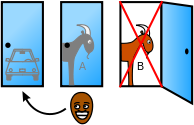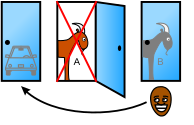The analysis can be illustrated in terms of the equally likely events that the player has initially chosen the car, goat A, or goat B ( Economist 1999):
The analysis can be illustrated in terms of the equally likely events that the player has initially chosen the car, goat A, or goat B ( Economist 1999):
| |||||||||||||||||||||||||||
The player has an equal chance of initially selecting the car, Goat A, or Goat B. Switching results in a win 2/3 of the time.
| |||||||||||||||||||||||||||





